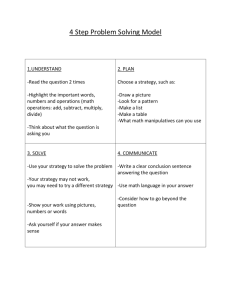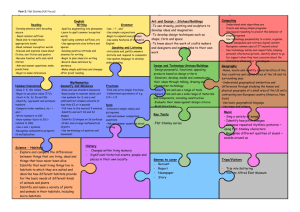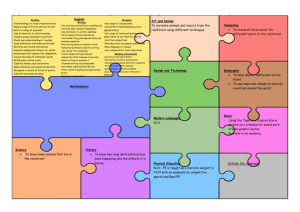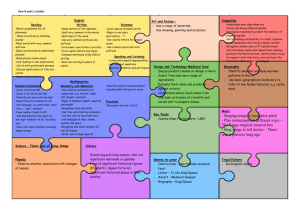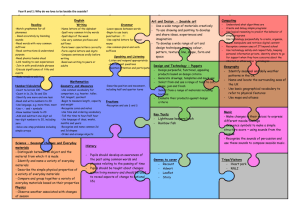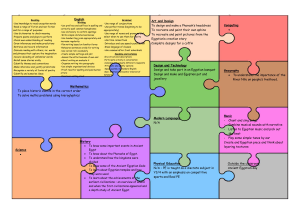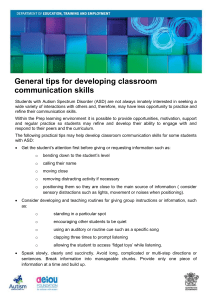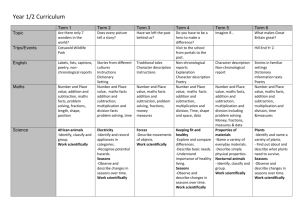Stages of Second Language Acquisition
advertisement
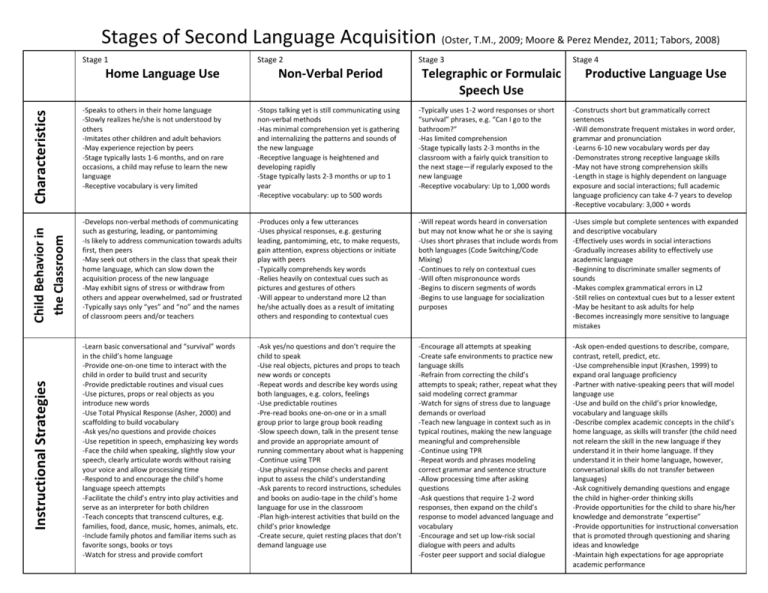
Stages of Second Language Acquisition (Oster, T.M., 2009; Moore & Perez Mendez, 2011; Tabors, 2008) Stage 1 Instructional Strategies Child Behavior in the Classroom Characteristics Home Language Use Stage 2 Non-Verbal Period Stage 3 Telegraphic or Formulaic Speech Use Stage 4 Productive Language Use -Speaks to others in their home language -Slowly realizes he/she is not understood by others -Imitates other children and adult behaviors -May experience rejection by peers -Stage typically lasts 1-6 months, and on rare occasions, a child may refuse to learn the new language -Receptive vocabulary is very limited -Stops talking yet is still communicating using non-verbal methods -Has minimal comprehension yet is gathering and internalizing the patterns and sounds of the new language -Receptive language is heightened and developing rapidly -Stage typically lasts 2-3 months or up to 1 year -Receptive vocabulary: up to 500 words -Typically uses 1-2 word responses or short “survival” phrases, e.g. “Can I go to the bathroom?” -Has limited comprehension -Stage typically lasts 2-3 months in the classroom with a fairly quick transition to the next stage—if regularly exposed to the new language -Receptive vocabulary: Up to 1,000 words -Constructs short but grammatically correct sentences -Will demonstrate frequent mistakes in word order, grammar and pronunciation -Learns 6-10 new vocabulary words per day -Demonstrates strong receptive language skills -May not have strong comprehension skills -Length in stage is highly dependent on language exposure and social interactions; full academic language proficiency can take 4-7 years to develop -Receptive vocabulary: 3,000 + words -Develops non-verbal methods of communicating such as gesturing, leading, or pantomiming -Is likely to address communication towards adults first, then peers -May seek out others in the class that speak their home language, which can slow down the acquisition process of the new language -May exhibit signs of stress or withdraw from others and appear overwhelmed, sad or frustrated -Typically says only “yes” and “no” and the names of classroom peers and/or teachers -Produces only a few utterances -Uses physical responses, e.g. gesturing leading, pantomiming, etc, to make requests, gain attention, express objections or initiate play with peers -Typically comprehends key words -Relies heavily on contextual cues such as pictures and gestures of others -Will appear to understand more L2 than he/she actually does as a result of imitating others and responding to contextual cues -Will repeat words heard in conversation but may not know what he or she is saying -Uses short phrases that include words from both languages (Code Switching/Code Mixing) -Continues to rely on contextual cues -Will often mispronounce words -Begins to discern segments of words -Begins to use language for socialization purposes -Uses simple but complete sentences with expanded and descriptive vocabulary -Effectively uses words in social interactions -Gradually increases ability to effectively use academic language -Beginning to discriminate smaller segments of sounds -Makes complex grammatical errors in L2 -Still relies on contextual cues but to a lesser extent -May be hesitant to ask adults for help -Becomes increasingly more sensitive to language mistakes -Learn basic conversational and “survival” words in the child’s home language -Provide one-on-one time to interact with the child in order to build trust and security -Provide predictable routines and visual cues -Use pictures, props or real objects as you introduce new words -Use Total Physical Response (Asher, 2000) and scaffolding to build vocabulary -Ask yes/no questions and provide choices -Use repetition in speech, emphasizing key words -Face the child when speaking, slightly slow your speech, clearly articulate words without raising your voice and allow processing time -Respond to and encourage the child’s home language speech attempts -Facilitate the child’s entry into play activities and serve as an interpreter for both children -Teach concepts that transcend cultures, e.g. families, food, dance, music, homes, animals, etc. -Include family photos and familiar items such as favorite songs, books or toys -Watch for stress and provide comfort -Ask yes/no questions and don’t require the child to speak -Use real objects, pictures and props to teach new words or concepts -Repeat words and describe key words using both languages, e.g. colors, feelings -Use predictable routines -Pre-read books one-on-one or in a small group prior to large group book reading -Slow speech down, talk in the present tense and provide an appropriate amount of running commentary about what is happening -Continue using TPR -Use physical response checks and parent input to assess the child’s understanding -Ask parents to record instructions, schedules and books on audio-tape in the child’s home language for use in the classroom -Plan high-interest activities that build on the child’s prior knowledge -Create secure, quiet resting places that don’t demand language use -Encourage all attempts at speaking -Create safe environments to practice new language skills -Refrain from correcting the child’s attempts to speak; rather, repeat what they said modeling correct grammar -Watch for signs of stress due to language demands or overload -Teach new language in context such as in typical routines, making the new language meaningful and comprehensible -Continue using TPR -Repeat words and phrases modeling correct grammar and sentence structure -Allow processing time after asking questions -Ask questions that require 1-2 word responses, then expand on the child’s response to model advanced language and vocabulary -Encourage and set up low-risk social dialogue with peers and adults -Foster peer support and social dialogue -Ask open-ended questions to describe, compare, contrast, retell, predict, etc. -Use comprehensible input (Krashen, 1999) to expand oral language proficiency -Partner with native-speaking peers that will model language use -Use and build on the child’s prior knowledge, vocabulary and language skills -Describe complex academic concepts in the child’s home language, as skills will transfer (the child need not relearn the skill in the new language if they understand it in their home language. If they understand it in their home language, however, conversational skills do not transfer between languages) -Ask cognitively demanding questions and engage the child in higher-order thinking skills -Provide opportunities for the child to share his/her knowledge and demonstrate “expertise” -Provide opportunities for instructional conversation that is promoted through questioning and sharing ideas and knowledge -Maintain high expectations for age appropriate academic performance
